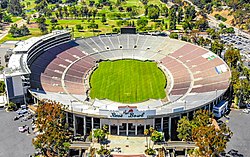
The Women's United Soccer Association (WUSA) was the world's first women's soccer league in which all the players were paid as professionals. Founded in February 2000, the league began its first season in April 2001 with eight teams in the United States. The league suspended operations on September 15, 2003, shortly after the end of its third season, after making cumulative losses of around US$100 million.

Brandi Denise Chastain is an American retired soccer player, two-time FIFA Women's World Cup champion, two-time Olympic gold-medalist, coach, and sports broadcaster. She played for the United States national team from 1988 to 2004. In her 192 caps on the team, she scored 30 goals playing primarily in the defender and midfielder positions. She scored a World Cup-winning penalty shootout goal against China in the 1999 FIFA Women's World Cup final.

Mariel Margaret "Mia" Hamm is an American former professional soccer player, two-time Olympic gold medalist and two-time FIFA Women's World Cup champion. Hailed as a soccer icon, she played as a forward for the United States national team from 1987 to 2004. Hamm was the face of the Women's United Soccer Association (WUSA), the first professional women's soccer league in the United States, where she played for the Washington Freedom from 2001 to 2003. She played college soccer for the North Carolina Tar Heels and helped the team win four NCAA Division I Women's Soccer Championship titles.

The FIFA Women's World Cup is an international association football competition contested by the senior women's national teams of the members of Fédération Internationale de Football Association (FIFA), the sport's international governing body. The competition has been held every four years and one year after the men's FIFA World Cup since 1991, when the inaugural tournament, then called the FIFA Women's World Championship, was held in China. Under the tournament's current format, national teams vie for the remaining 31 slots in a three-year qualification phase. The host nation's team is automatically entered as the first slot. The tournament, called the World Cup Finals, is contested at venues within the host nation(s) over about one month.
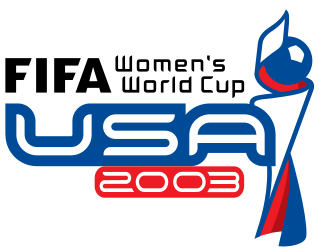
The 2003 FIFA Women's World Cup was the fourth edition of the FIFA Women's World Cup, the quadrennial championship of women's national soccer teams organized by FIFA. It was held in the United States from September 20 to October 12, 2003, at six venues in six cities across the country. The tournament was won by Germany, who became the first country to win both the men's and women's World Cup.

The 1999 FIFA Women's World Cup was the third edition of the FIFA Women's World Cup, the world championship for women's national soccer teams. It was hosted as well as won by the United States and took place from June 19 to July 10, 1999, at eight venues across the country. The tournament was the most successful FIFA Women's World Cup in terms of attendance, television ratings, and public interest.
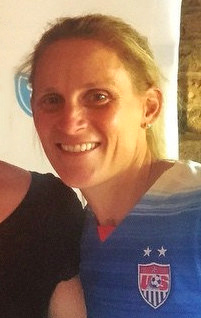
Kristine Marie Lilly Heavey is an American former professional soccer player. She was a member of the United States women's national team for 23 years and is the most-capped football player in the history of the sport, gaining her 354th and final cap against Mexico in a World Cup qualifier in November 2010. Lilly scored 130 international goals for the US national team, making her the team's fourth-highest goal scorer behind Carli Lloyd's 134, Mia Hamm's 158 goals, and Abby Wambach's 184.
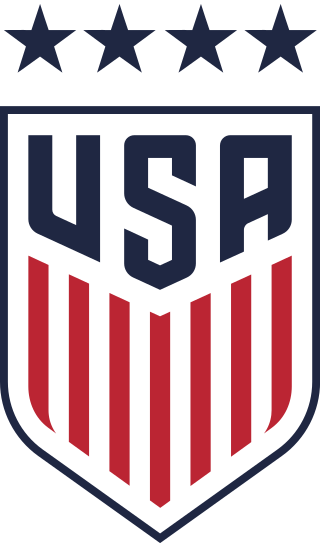
The United States women's national soccer team (USWNT) represents the United States of America in international women's soccer. The team is governed by United States Soccer Federation and competes in CONCACAF.

Julie Maurine Foudy is an American retired soccer midfielder, two-time FIFA Women's World Cup champion and two-time Olympic gold medalist. She played for the United States women's national soccer team from 1988 to 2004. Foudy finished her international career with 274 caps and served as the team's captain from 2000 to 2004 as well as the co-captain from 1991 to 2000. In 1997, she was the first American and first woman to receive the FIFA Fair Play Award.
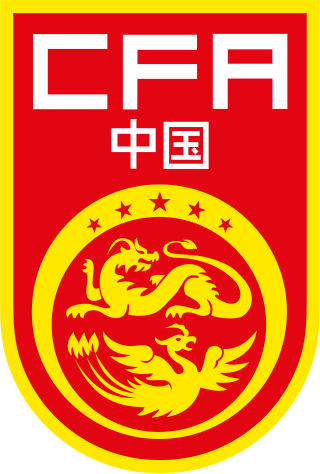
The China women's national football team represents the People's Republic of China in international women's football competitions and is governed by the Chinese Football Association.

Briana Collette Scurry is an American retired soccer goalkeeper, and assistant coach of the Washington Spirit as of 2018. Scurry was the starting goalkeeper for the United States women's national soccer team at the 1995 World Cup, 1996 Summer Olympics, 1999 World Cup (champions), 2003 World Cup, and the 2004 Summer Olympic Games. She played in the semi-final and playoff for third place in the 2007 Women's World Cup. She was a founding member of the WUSA, playing three seasons as starting goalkeeper for the Atlanta Beat (2001–2003).

Shannon Ann MacMillan is an American retired soccer player, coach, FIFA Women's World Cup champion, Olympic gold and silver medalist. Named U.S. Soccer Athlete of the Year for 2002, MacMillan played for the United States women's national soccer team from 1994 to 2006 and was part of the 1999 FIFA Women's World Cup-winning team. She won gold with the team at the 1996 Summer Olympics and silver at the 2000 Summer Olympics.

Cynthia Marie Parlow Cone is an American soccer executive and president of the United States Soccer Federation. A former professional soccer player, she is a two-time Olympic Gold medalist and 1999 FIFA Women's World Cup champion. As head coach in 2013, Parlow Cone led the Portland Thorns FC to clinch the inaugural National Women's Soccer League (NWSL) championship title.
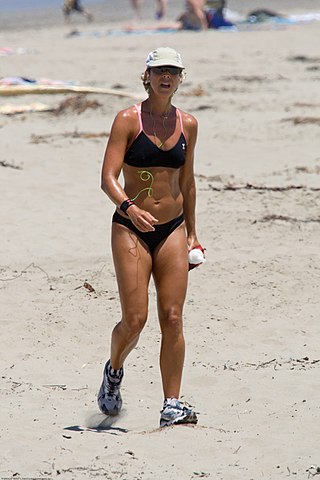
A sports bra is a bra that provides support to the breasts during physical exercise. Sturdier than typical bras, they minimize breast movement and alleviate discomfort. Many women wear sports bras to reduce pain and physical discomfort caused by breast movement during exercise. Some sports bras are designed to be worn as outerwear during exercise such as running. There are also sports bras with extra padding for exercises that involve some kind of trauma to the breasts.
Gao Hong is a Chinese former footballer who played as a goalkeeper. She competed in the 1996 Summer Olympics and in the 2000 Summer Olympics. She also played professionally for the New York Power of the Women's United Soccer Association in 2001 and 2002.

Soccer is not traditionally a major mainstream sport in Canada, but the sport is growing especially in places like Nova Scotia. Up to 85,000 girls participate in soccer, which is 41% of all youth in the country. The 2015 FIFA Women's World Cup was hosted in Canada.

The history of the United States women's national soccer team began in 1985 — the year when the United States women's national soccer team played its first match.

The Japan–United States women's soccer rivalry is a sports rivalry between the national women's soccer teams of Japan and the United States, two of the most successful women's football nations in the world, having achieved eight straight Women's World Cup appearances between the two countries. However, the United States has dominated Japan since 1986, having won 31 of the 40 matches. The U.S. maintained a 13-match winning streak from 1986 through 2000. Japan upsets the U.S. 1–0, their first ever win in regulation for Japan, and subsequently the Algarve Cup final against Germany, but finished as the runners-up after a 4–3 loss.
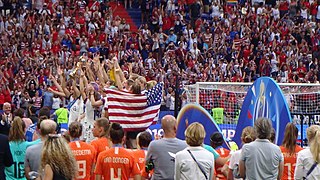
The United States women's national soccer team is the most successful women's national team in the history of the Women's World Cup, having won four titles, earning second-place once and third-place finishes three times. The United States is one of five countries including Germany, Japan, Norway, and Spain to win a FIFA Women's World Cup.. The United States was also the only team that played the maximum number of matches possible in every tournament until they got eliminated in the round of 16 in 2023.
Marla Messing is an American attorney and sports executive. She is known primarily for her work in soccer – first with the 1994 FIFA World Cup and as one of the first executives of Major League Soccer in 1995. In 1996, Messing became president and chief executive officer of the committee that organized the 1999 FIFA Women's World Cup. Most recently, Messing served as the interim CEO of the National Women's Soccer League. From 2019 to 2021 she was the CEO of USTA Southern California.
